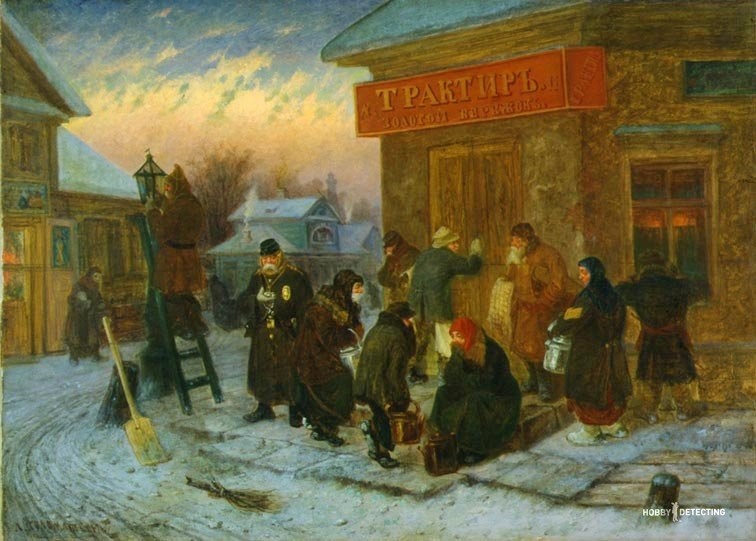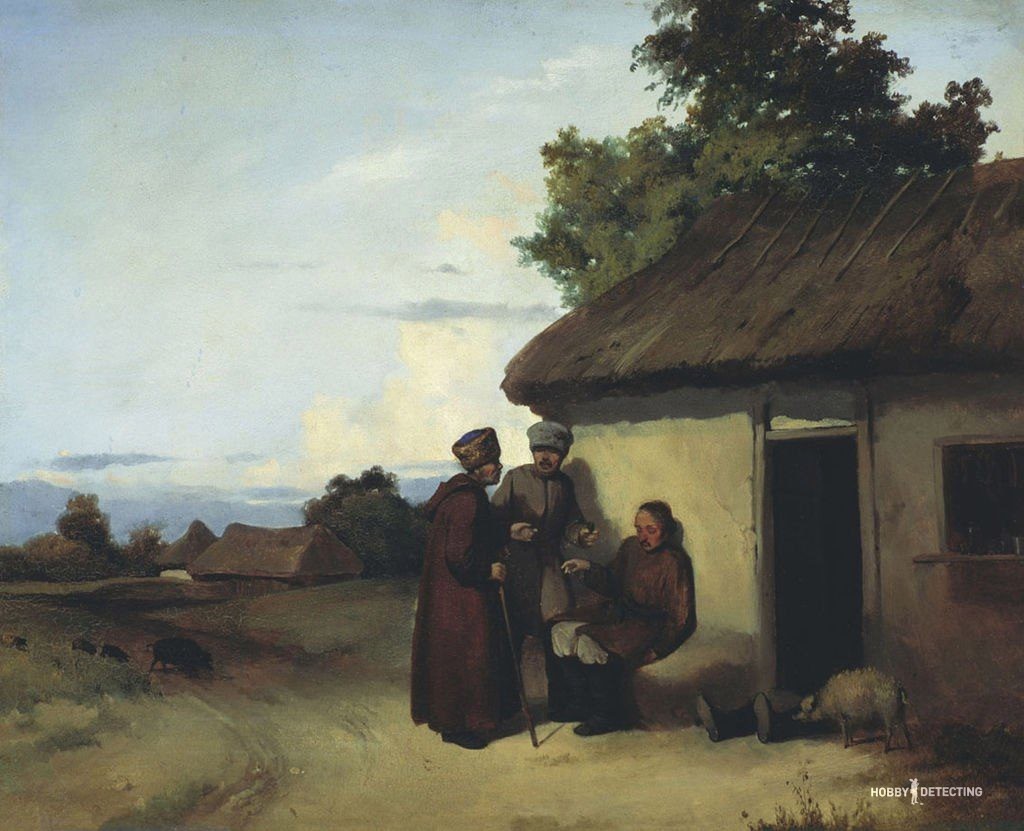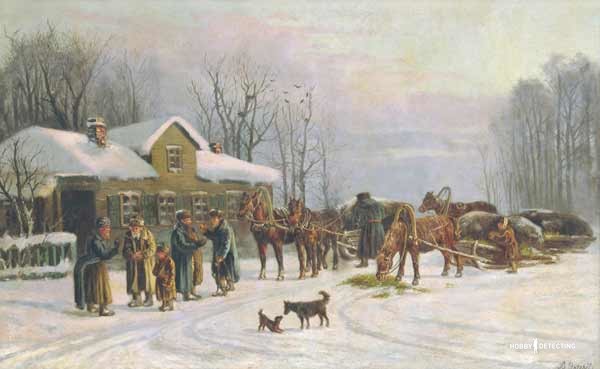Drinking establishments and inns (Tips for diggers+)
Searching for antiquities is quite a fun and exciting activity. After all, who among us in childhood did not want to go in search of hidden ancient treasures? Of those grown-up children, many remained romantics and adventurers at heart, acquired metal detectors, and began to engage in such a unique hobby as treasure hunting. Thus making your childhood dreams come true. Of course, hardly anyone managed to find large treasures, but here are various lost ancient coins, buttons, crosses, etc. These people found quite a few.

Painting by artist L.I. Solomatkin “Morning at the tavern”. 1860s.
It is worth noting that literally a couple of hundred years ago, coins were much more common than now, when cash is increasingly being replaced by electronic means of payment. It is reasonable to assume that coins were lost much more often at that time, and if you know how to look for them, and most importantly, in what places to do this, then you can easily acquire excellent finds, if only you had the desire and the necessary equipment. Before you go searching for antiquities, I would advise you to familiarize yourself with the historical location of cities and settlements on old maps. After all, it goes without saying that their locations changed over time, and where a spacious plain or forest now stretches, there could previously have been ancient settlements, and in them (or somewhere in the immediate vicinity): inns, taverns, taverns, taverns and other drinking establishments. We will talk about searches in such places in more detail in this article. Now about everything in order…
FIRST LET’S UNDERSTAND THE CONCEPTS
Содержание статьи:

Painting by artist V.G. Perov. «The last tavern at the outpost». 1868
After the emergence and spread of strong alcoholic beverages in the Middle Ages, private drinking establishments began to be used for their sale. In Europe these were taverns. In the territories of Poland, Ukraine, and Belarus, such a drinking establishment was called a tavern or tavern. In the central part of Rus’ and in Siberia, the analogue was a tavern or tavern.
Such drinking establishments were divided into two types: without a drive-in (non-drive-in) and with a drive-in (drive-in). The first ones (taverns and taverns) were intended for selling drinks and food to the population and travelers, and were meeting places for merchants and local people. The second (taverns and taverns), in addition, provided sleeping places for merchants arriving at local fairs, and for rest for travelers traveling on their own horses or on foot.

Painting by Sternberg V.I. “Little Russian tavern” 1837
Inns were intended for the more privileged public. Traveling nobles, officials and rich merchants found food and lodging there. In Rus’, the predecessors of the first inns (hotels) were “pits”. They were located at a distance of horse riding from each other.
All of the above establishments were built in a convenient and easily accessible location, for example — near public roads, at the entrance to a populated area or at the main shopping area, near monasteries, at the intersection of trade routes, at the borders of property. And also in large villages, along large highways, at crossings and other crowded places.
WHAT ARE THE INTERESTING ESTABLISHMENTS AND INNS?

Painting by unknown artist
It was places like these that gathered wanderers and those simply wanting to relax and have a drink or two after a hard day at work. Finding coins in such places is not uncommon, since their turnover here was quite high. In this case, the coins did not necessarily have to be lost – it may even be that some of their stock was hidden by the owner of the establishment or a cautious guest who was afraid of robbery. Almost any inn, tavern, tavern or other drinking establishment had trampled paths from the surrounding villages along which men, overwhelmed by work and everyday life, walked to spend their hard-earned coins and relax a little. So life there was in full swing, coins were jingling, vodka and wine were flowing like a river, and here and there prowling girls were squealing … If it is possible to determine exactly where such a building stood, then it is also necessary, if possible, to trace the path from the road to the entrance. If there is a body of water nearby (river, lake) — then the way to it. Well, and the adjacent area, of course. By the way, sometimes murders took place there and the victim could bury himself nearby. So, when digging a deep signal, be mentally prepared that human bones may turn out of the ground under the shovel.
WHAT FINDS ARE FOUND IN SUCH PLACES?

Aficionados of instrumental searching in such places were able to find various types of copper and silver coins of the Russian Empire with varying degrees of success. In addition to ancient coins, there were copper uniform buttons of soldiers, officers, high and low ranks of the tsarist army, as well as rings, rings, crosses, items of horse harness, lead seals, various types of spent cartridges, etc. But inns and taverns, as well as fairs, places of former churches and estates are identified first by experienced search engines, especially those indicated on maps.
TRACT STANDS
Also, at drinking establishments you often come across round, hexagonal, octagonal or other shaped coins without a coat of arms. They only indicate the payment denomination – 5 kopecks, 15 kopecks, 25 rubles, etc. These are exchange surrogates (payment tokens), which are called tavern marks. These “surrogates” appeared in the middle of the 19th century and at first were used only for payments between the waiter, cashier and visitors in taverns. Simply put, it was a kind of cash receipt.
A little later, having appreciated the ease of use, tavern stamps began to be used instead of change when paying clients of drinking establishments. However, such tokens could only be “shopped” where they were obtained.
WHERE TO LOOK FOR SIMILAR ESTABLISHMENTS?
You should look for such establishments (inns, taverns, taverns, taverns, taverns, taverns) on the outskirts of former settlements and at major junctions.
Inns were often located at some distance from villages. It will be more difficult to localize such objects, and many beginners, when looking at maps, do not even pay attention to such designations.
CONCLUSION

Searching at the sites of ancient drinking establishments and inns can easily be called the most interesting type of searching for antiquities, since it is here that interesting and rare types of coins can be found. Unlike ordinary farmsteads, inns were often visited by different types of people: military personnel, civil servants, workers, peasants, officials and travelers. Places of such historical interest can give the searcher many pleasant memories of searching with a metal detector.
Author of the article: Denis Shibaev
